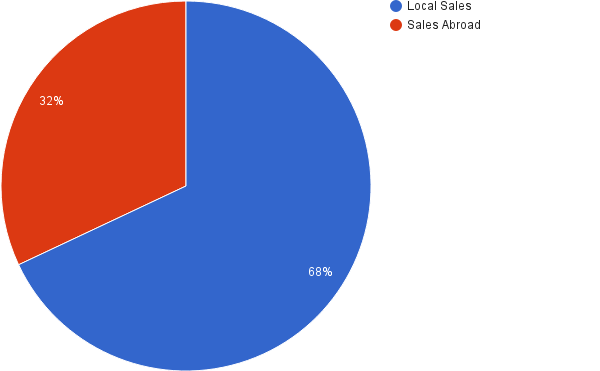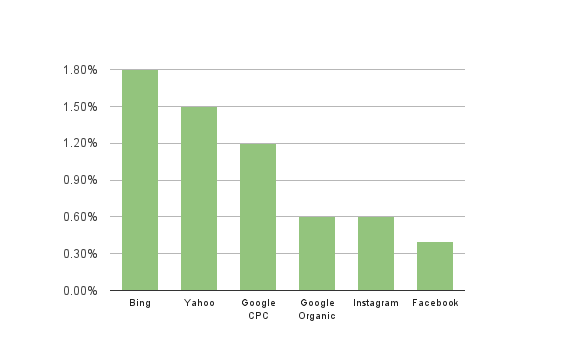The data is in and boy do we have some exclusive insights for you.
At the beginning of October our analysts got busy, really busy. We wanted to delve into the numbers to find out what key insights we could find in $150 million worth of sales. Insights that we knew would be invaluable for all eCommerce small businesses. And things got super interesting.
We took all the unique data we have access to while providing Marketing apps for 150,000 SMBs and managing the advertising efforts for tens of thousands of them, and analyzed where $150,000,000 in recent sales were generated from.
Our analysis was based on heaps of Google Analytics data from thousands of our merchants which we were able to segment into sources, countries, devices and demographics to see exactly what was responsible for the total of $150,000,000 in sales. From this data we were able to pinpoint four vital statistics that other small business can benefit from.
Here are the invaluable insights from this exclusive eCommerce sales data:
1. Shipping abroad can increase your sales by 50%
This is huge! Over 35% of the $150 million worth of sale we analyzed come directly from selling and shipping overseas; to places outside of the country where stores are based. Revealing that small businesses who are not already shipping overseas can increase their sales by up to 50% just by widening their market globally.
That’s not chump change; and it’s not only the profit that improves. International sales mean international exposure, additional links, additional branding and ultimately more traffic internationally and locally for your online store.
Changing your online business to include international shipping doesn’t have to be as scary as you think. Here are some tips to get you started:
Deciding Where to Ship To Next
Start with a few countries first, before offering full worldwide shipping to test the market and grow your international market more slowly. For example, American sellers tend to begin with Canada, the U.K. and Australia. Taking a look at your Google Analytics will give you an idea of where existing outside traffic is coming from and which countries look like a good starting point.
Keep Marketing Simple
Start with a simple website banner, Facebook post and email marketing campaign to announce that you’re now taking international orders.
Paid Shipping a Budget Friendly Option
If you’re worried about your budget and you’re currently offering free shipping locally, you don’t need to necessarily compete with free shipping in the worldwide shipping market. Free shipping competition is less competitive in the worldwide market which therefore gives you the opportunity to offer international shipping with not too much additional cost.
2. Mobile is now responsible for 35% of sales
The general consensus at the beginning of 2016 was that even though eCommerce mobile search was rising, mobile sales were slow. The reason being, shoppers were found to be reluctant to purchase products on their mobile devices. But, almost a year later, the data has changed. Although desktop is still the sales king with regard to devices, mobile is gaining much quicker than expected and these stats prove it.
Of the $150 million worth of online store sales generated, $46 million was generated through mobile devices.
These stats show us that online stores not optimizing and catering for mobile shoppers are missing out in a big way. In other words, catering for mobile shoppers could increase your sales by up to 35% if you’re not already doing it.
Here are two ways you can improve your mobile user experience to help convert those mobile sales:
Revamp Content Display
Most users do not use their mobiles in the same way they would use their desktop and your mobile site needs to take that into consideration. Such as highly accessible contact details and instant chat, which become much more important as mobile users are more inclined to want instant, faster answers.
Add Some Features
Not to mention mobile versions of sites will require more scrolling than desktop sites. Using plugins and tools to make content reading easier, such as mini tables of content and direct access buttons, will go a long to converting mobile traffic to mobile sales.
3. Google Organic accounts for 50% of ad-network sales
During our deep analysis, we looked at which traffic sources were bringing in the highest revenue out of the $150 million total sales. When it comes to online eCommerce sales, Google Organic takes top position with a resounding 50% of the revenue. Not surprisingly, next is Facebook which brings in up to 25% of orders and 35% of revenue, followed by Google CPC, which brings in 11% of the revenue and 18% of the orders. While Yahoo and Bing only made up for 5% of the sales together. In money terms, this is huge.
This eCommerce sales data also gives other businesses a clear idea of where they should be spending their time and money on. In addition, it reminds us that cheaper is not always better and when looking at the pay per click rate, it’s also important to consider conversion rates.
Google organic is one of the biggest non-paid leading traffic sources and there are a number of ways you can improve your Organic rate and therefore by default your sales. To get a crash course in all the basics around SEO, Moz’s SEO guide is a great place to start. Plus, here are some of the basic must-haves for good SEO.
Provide Quality Content
Adding a blog to your online store, offering high quality, relevant content within your niche, is a Google organic must. Compelling content not only brings more shoppers to your website while instilling more trust, but the more your content is shared, the higher you will be rewarded in terms of ranking.
Put Effort Into Your Meta Descriptions
Meta descriptions, which describe the content of the page that appears in your search, will help your click-through rate. Clicks lead to traffic, and traffic that stays on your site to see what you have or read what you have to say means a better bounce rate. All contributing to your overall Google ranking.
Track Your Traffic
To improve your traffic and ultimately your SEO results, it’s important to see where your site traffic is coming from, how your site is functioning and how results change when different tags or titles etc. are used. In other words, allowing you to A/B test until you find the winning SEO optimization for your brand and niche. You can see this info through Google Analytics or our free, user-friendly Traffic Tracker.
But why would you want to use Bing and Yahoo if it only brings in 5% of the revenue you may ask? Because surprisingly, we found that they have the best conversion rates!
4. StoreYa has a better conversion rate than Google CPC
When it comes to converting, StoreYa apps (Yay us!) scored higher than Google CPC. While Bing’s conversion rate is higher than Yahoo’s, Facebook is generally the lowest converting performer. Given that Facebook does bring in 35% of the revenue, a low conversion rate means you have to put a lot more spend to get this ad network to perform.
Google CPC was found to have a better conversion rate than Google Organic. This can be explained as follows:
- In many of the cases paid ads come before the organic results and therefore get the higher click-through rate and in turn the higher conversion rate.
- Paid ads come with a much cleaner format and call to actions, which can increase conversion rates.
StoreYa’s Traffic Booster was found to have a better conversion rate than Google CPC. This can be explained by our algorithms and automatic optimization methods which derives from our vast experience in the field and which is constantly growing and improving. Plus, our ability to optimize the campaigns in real-time is a huge asset.
Here are a few quick ways you can improve your conversion rates across the board.
- A/B test your CTA (call to action) buttons until you get the best results.
- Add customer reviews to your site.
- Add online chat to improve customer service as well as conversion rates.
- Make sure your contact info is front and center.
- Offer bonus discounts with apps like Coupon Pop.
I hope these 4 eCommerce sales data insights help you with your strategies moving into the Christmas shopping frenzy and onto 2017. If you have any questions, comments and/or insights of your own, I would love to hear from you in the comments below.

Nicole is a content writer at StoreYa with over sixteen years experience and flair for storytelling. She runs on a healthy dose of caffeine and enthusiasm. When she's not researching the next content trend or creating informative small business content, she's an avid beachgoer, coffee shop junkie and hangs out on LinkedIn.
Recommended articles
 Facebook Ads for eCommerce: 16 Strategies, Examples & Tips
Facebook Ads for eCommerce: 16 Strategies, Examples & Tips
 How to Build a Winning eCommerce Ads Strategy
How to Build a Winning eCommerce Ads Strategy
 Google Ads for eCommerce: Everything You Need to Know
Google Ads for eCommerce: Everything You Need to Know
 10X Your Traffic with PPC Management Software
10X Your Traffic with PPC Management Software
Comments
Powered by Facebook Comments






